目录
2.2 string类的常用接口说明(注意下面我只讲解最常用的接口)
【本节目标】
1. 为什么要学习string类
2. 标准库中的string类
3. string类的模拟实现
4. 扩展阅读
1.为什么学习string类?
1.1C语言中的字符串
C语言中,字符串是以'\0'结尾的一些字符的集合,为了操作方便,C标准库中提供了一些str系列的库函数,但是这些库函数与字符串是分离开的,不太符合OOP的思想,而且底层空间需要用户自己管理,稍不留神可能还会越界访问。
1.2两个面试题(暂不做讲解)
字符串转整形数字
字符串相加
在OJ中,有关字符串的题目基本以string类的形式出现,而且在常规工作中,为了简单、方便、快捷,基本都使用string类,很少有人去使用C库中的字符串操作函数。
2.标准库中的string类
2.1 string类(了解)
1. 字符串是表示字符序列的类
2. 标准的字符串类提供了对此类对象的支持,其接口类似于标准字符容器的接口,但添加了专门用于操作单字节字符字符串的设计特性。
3. string类是使用char(即作为它的字符类型,使用它的默认char_traits和分配器类型(关于模板的更多信息,请参阅basic_string)。
4. string类是basic_string模板类的一个实例,它使用char来实例化basic_string模板类,并用char_traits和allocator作为basic_string的默认参数(根于更多的模板信息请参考basic_string)。
5. 注意,这个类独立于所使用的编码来处理字节:如果用来处理多字节或变长字符(如UTF-8)的序列,这个类的所有成员(如长度或大小)以及它的迭代器,将仍然按照字节(而不是实际编码的字符)来操作。
总结:
1. string是表示字符串的字符串类
2. 该类的接口与常规容器的接口基本相同,再添加了一些专门用来操作string的常规操作。3. string在底层实际是:basic_string模板类的别名,typedef basic_string<char, char_traits, allocator>string;
4. 不能操作多字节或者变长字符的序列。注意:
在使用string类时,必须包含#include头文件以及using namespace std;

2.2 string类的常用接口说明(注意下面我只讲解最常用的接口)
1. string类对象的常见构造
| (constructor)函数名称 | 功能说明 |
| string() (重点) | 构造空的string类对象,即空字符串 |
| string(const char* s) (重点) | 用C-string来构造string类对象 |
| string(size_t n, char c) | string类对象中包含n个字符c |
| string(const string&s) (重点) | 拷贝构造函数 |
void test_string1()
{
// 21:16
string s0;
string s1("hello world");
string s2(s1);
string s3(s1, 5, 3);
string s4(s1, 5, 10);
string s5(s1, 5);
cout << s0 << endl;
cout << s1 << endl;
cout << s2 << endl;
cout << s3 << endl;
cout << s4 << endl;
cout << s5 << endl;
string s6(10, '#');
cout << s6 << endl;
s0 = s6;
cout << s0 << endl;
}s0为默认构造
s1为单参数构造
s2为拷贝构造
s3为字符串中的只构造s1中的一部分(已经构造出的对象,字符串中的位置,从此位置后框选字符的长度),s4中框选的长度可以更大,如果超出范围,则框选从选中位置之后的所有字符,s5中没有第三参数时和s4相同。
s6为初始化为##########
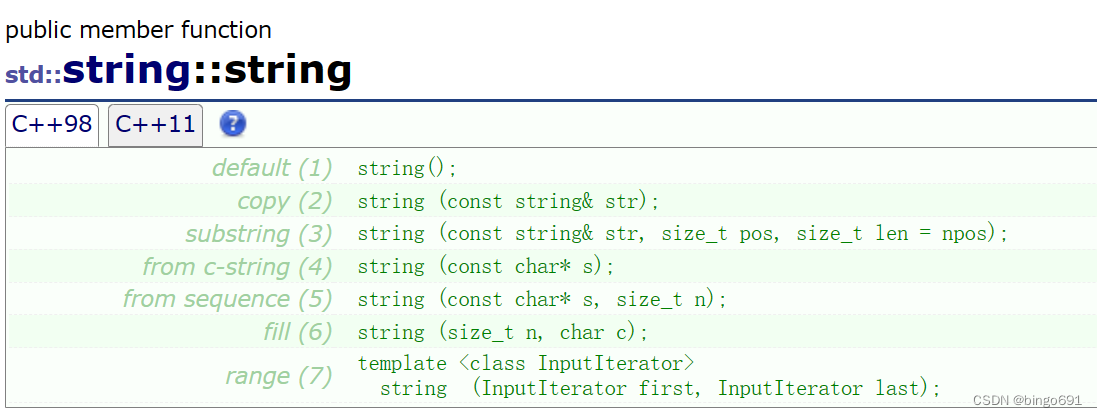
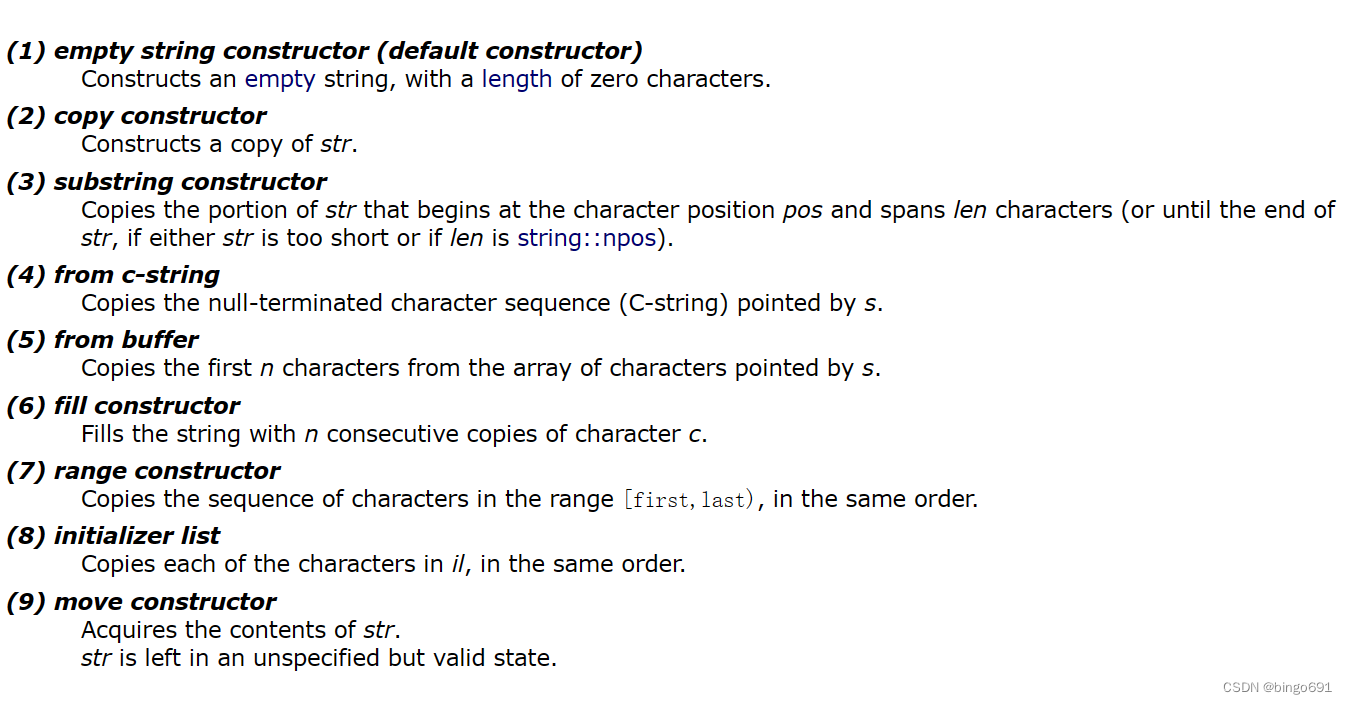
2. string类对象的容量操作
| 函数名称 | 功能说明 |
| size(重点) | 返回字符串有效字符长度 |
| length | 返回字符串有效字符长度 |
| capacity | 返回空间总大小 |
| empty (重点) | 检测字符串释放为空串,是返回true,否则返回false |
| clear (重点) | 清空有效字符 |
| reserve (重点) | 为字符串预留空间** |
| resize (重点) | 将有效字符的个数该成n个,多出的空间用字符c填充 |
注意:
1. size()与length()方法底层实现原理完全相同,引入size()的原因是为了与其他容器的接口保持一致,一般情况下基本都是用size()。
2. clear()只是将string中有效字符清空,不改变底层空间大小。
3. resize(size_t n) 与 resize(size_t n, char c)都是将字符串中有效字符个数改变到n个,不同的是当字符个数增多时:resize(n)用0来填充多出的元素空间,resize(size_t n, char c)用字符c来填充多出的元素空间。注意:resize在改变元素个数时,如果是将元素个数增多,可能会改变底层容量的大小,如果是将元素个数减少,底层空间总大小不变。
4. reserve(size_t res_arg=0):为string预留空间,不改变有效元素个数,当reserve的参数小于string的底层空间总大小时,reserver不会改变容量大小。
3. string类对象的访问及遍历操作
| 函数名称 | 功能说明 |
| operator[] (重 点) | 返回pos位置的字符,const string类对象调用 |
| begin+ end | begin获取一个字符的迭代器 + end获取最后一个字符下一个位置的迭 代器 |
| rbegin + rend | begin获取一个字符的迭代器 + end获取最后一个字符下一个位置的迭 代器 |
| 范围for | C++11支持更简洁的范围for的新遍历方式 |
第一种遍历:for循环遍历
string s1("hello world");
// 第一种遍历
// 下标+[]
for (size_t i = 0; i < s1.size(); i++)
{
cout << s1[i] << " ";
//cout << s1.operator[](i) << " ";
}
cout << endl;
for (size_t i = 0; i < s1.size(); i++)
{
s1[i]++;
}
cout << endl;
for (size_t i = 0; i < s1.size(); i++)
{
cout << s1[i] << " ";
}
cout << endl;第二种遍历:迭代器(迭代器中begin与end之间不包含\0)
string s3("hello world");
string::iterator it3 = s3.begin();
while (it3 != s3.end())
{
*it3 -= 3;
++it3;
}
cout << endl;
it3 = s3.begin();
while (it3 != s3.end())
{
cout << *it3 << " ";
++it3;
}
cout << endl;
vector<int> v;
v.push_back(1);
v.push_back(2);
v.push_back(3);
v.push_back(4);
vector<int>::iterator it = v.begin();
while (it != v.end())
{
cout << *it << " ";
++it;
}
cout << endl;
list<int> lt;
lt.push_back(1);
lt.push_back(2);
lt.push_back(3);
lt.push_back(4);
list<int>::iterator itt = lt.begin();
while (itt != lt.end())
{
cout << *itt << " ";
++itt;
}
cout << endl;
第三种遍历:
string s3("hello world");
// 底层就是迭代器
for (auto e : s3)
{
cout << e << " ";
}
cout << endl;
for (auto e : v)
{
cout << e << " ";
}
cout << endl;
for (auto e : lt)
{
cout << e << " ";
}
cout << endl;4. string类对象的修改操作
| 函数名称 | 功能说明 |
| push_back | 在字符串后尾插字符c |
| append | 在字符串后追加一个字符串 |
| operator+= (重点) | 在字符串后追加字符串str |
| c_str(重点) | 返回C格式字符串 |
| find + npos(重点) | 从字符串pos位置开始往后找字符c,返回该字符在字符串中的位置 |
| rfind | 从字符串pos位置开始往前找字符c,返回该字符在字符串中的位置 |
| substr | 在str中从pos位置开始,截取n个字符,然后将其返回 |
注意:
1. 在string尾部追加字符时,s.push_back(c) / s.append(1, c) / s += 'c'三种的实现方式差不多,一般情况下string类的+=操作用的比较多,+=操作不仅可以连接单个字符,还可以连接字符串。
2. 对string操作时,如果能够大概预估到放多少字符,可以先通过reserve把空间预留好。
5. string类非成员函数
| 函数 | 功能说明 |
| operator+ | 尽量少用,因为传值返回,导致深拷贝效率低 |
| operator>> (重点) | 输入运算符重载 |
| operator<< (重点) | 输出运算符重载 |
| getline (重点) | 获取一行字符串 |
| relational operators (重点) | 大小比较 |
上面的几个接口大家了解一下,下面的OJ题目中会有一些体现他们的使用。string类中还有一些其他的操作,这里不一一列举,大家在需要用到时不明白了查文档即可。
class string
{
public:
char& operator[](size_t pos)
{
return _str[pos];
}
private:
char* _str;
size_t _size;
size_t _capacity;
};2.3 string类(cplusplus)
Iterators(迭代器):
begin 顺序的,元素最开始的位置 end 顺序的,元素最后的位置(不包含\0) rbegin 逆序的,元素从最末尾的位置开始 rend 逆序的,元素从最开始的位置结束 cbegin 顺序的,元素最开始的位置(const类型的对象) cend 顺序的,元素最后的位置(不包含\0)(const类型的对象) crbegin 逆序的,元素从最末尾的位置开始(const类型的对象) crend 逆序的,元素从最开始的位置结束(const类型的对象)
begin end
// 可读可写 string::iterator it2 = s1.begin(); while (it2 != s1.end()) { *it2 += 3; cout << *it2 << " "; ++it2; } cout << endl;rbegin rend
string s1("hello world"); string::reverse_iterator rit = s1.rbegin(); while (rit != s1.rend()) { cout << *rit << " "; ++rit; } cout << endl;cbegin cend
// 只读 const string s3("hello world"); string::const_iterator it3 = s3.cbegin(); while (it3 != s3.cend()) { // *it3 += 3; cout << *it3 << " "; ++it3; } cout << endl;crbegin crend
// 只读 const string s3("hello world"); string::const_iterator it3 = s3.crbegin(); while (it3 != s3.crend()) { // *it3 += 3; cout << *it3 << " "; ++it3; } cout << endl;
Capacity(容量):
size 对象字符串的长度(常用) length 对象字符串的长度 max_size string字符串所能达到的最大长度 resize 修改对象字符长度,可加相同的n个字符,可将字符减少到相应的字符长度,大于容量会扩容 capacity 对象字符开辟的容量 reserve 提前开辟一定的空间 clear 清空对象中的字符 empty 字符串是否为空 shrink_to_fit
会将空间容量适应对象的字符串大小(即capacity==size) size length max_size capacity
string s1("hello worldxxxxxxxxxxxxxxxxxxxxxxxxxxxxxxxxxxxxxxxxxxxxxxxxxxxxxxxxxxxxxxxxxxxxxxxxxxxxxxxxxxxxxxxxxxxxxxxxxxxxxxxxxxxxxxxxxxxxxxxxxxxxxxxxxxxxxxxxxxxxxxxx"); cout << s1.size() << endl; cout << s1.length() << endl; cout << s1.max_size() << endl; cout << s1.capacity() << endl;capacity扩容规则
string s; size_t sz = s.capacity(); cout << "capacity changed: " << sz << '\n'; cout << "making s grow:\n"; for (int i = 0; i < 100; ++i) { s.push_back('c'); if (sz != s.capacity()) { sz = s.capacity(); cout << "capacity changed: " << sz << '\n'; } } cout << s1 << endl; cout << s1.capacity() << endl; cout << s1.size() << endl;shrink_to_fit
// 缩容 s1.shrink_to_fit(); cout << s1.capacity() << endl; cout << s1.size() << endl;
Element access:
operator[] []的运算符重载 at at在字符串中的位置的字符 back 最后一个字符 front 第一个字符 at
string s1("xhello world"); cout << s1[5] << endl; cout << s1.at(5) << endl;
Modifiers:
operator+= +=运算符重载 append 尾插多个字符 push_back 尾插单个字符 assign 给出的字符串覆盖对象所有字符串 insert
在pos位置插入字符串 erase 出去pos位置几个字符,减少字符长度 replace 将pos位置上的字符可替换为多个字符 swap 交换对象字符串 pop_back push_back append
string s1("xhello world"); s1.push_back('!'); cout << s1 << endl; s1.append("hello bit"); cout << s1 << endl; s1.append(10, 'x'); cout << s1 << endl; string s2(" apple "); //s1.append(s2); //cout << s1 << endl; s1.append(++s2.begin(), --s2.end()); cout << s1 << endl; string s3("hello world"); s3 += ' '; s3 += "apple"; cout << s3 << endl;
assign insert erase replace swap
string s1("xhello world"); cout << s1 << endl; s1.assign(" xxxxx"); cout << s1 << endl; s1.insert(0, "yyyy"); cout << s1 << endl; s1.erase(5, 3); cout << s1 << endl; s1.erase(); cout << s1 << endl; // 21:10继续 string s2("hello world hello bit"); s2.replace(5, 1, "20%"); cout << s2 << endl; /*size_t pos = s2.find(' '); while (pos != string::npos) { s2.replace(pos, 1, "20%"); pos = s2.find(' '); } cout << s2 << endl;*/ // insert/erase/replace // 能少用就要少用,因为基本都要挪动数据,效率不高 string s3; s3.reserve(s2.size()); for (auto ch : s2) { if (ch != ' ') { s3 += ch; } else { s3 += "20%"; } } cout << s3 << endl; s2.swap(s3); cout << s2 << endl;
insert/erase/replace
能少用就要少用,因为基本都要挪动数据,效率不高
String operations:
c_str 将C++中string对象字符兼容C语言 data 获得string数据 get_allocator 获得内存池 copy 从对象字符串中拷贝部分字符到数组中 find 顺序找到字符在字符串中的位置 rfind 倒序找到字符在字符串中的位置 find_first_of 顺序找到匹配多个字符的位置 find_last_of 倒序找到匹配多个字符的位置 find_first_not_of 顺序找到不匹配多个字符的位置 find_last_not_of 倒序找到不匹配多个字符的位置 substr 呈现从当前字符位置开始长度的字符串 compare 比较 c_str 由于string对象中字符串可以不用\0,但c语言中必须有
string s1("hello world"); string filename("test.cpp"); FILE* fout = fopen(filename.c_str(), "r")rfind
//string s1("file.cpp"); string s1("file.c.tar.zip"); // 拿到文件的后缀 size_t pos1 = s1.rfind('.'); if (pos1 != string::npos) { string suffix = s1.substr(pos1); //string suffix = s1.substr(pos1, s1.size()-pos1); cout << suffix << endl; } else { cout << "没有后缀" << endl; }
find
string url2("https://legacy.cplusplus.com/reference/string/string/substr/"); string url1("http://www.baidu.com/s?ie=utf-8&f=8&rsv_bp=1&rsv_idx=1&tn=65081411_1_oem_dg&wd=%E5%90%8E%E7%BC%80%20%E8%8B%B1%E6%96%87&fenlei=256&rsv_pq=0xc17a6c03003ede72&rsv_t=7f6eqaxivkivsW9Zwc41K2mIRleeNXjmiMjOgoAC0UgwLzPyVm%2FtSOeppDv%2F&rqlang=en&rsv_dl=ib&rsv_enter=1&rsv_sug3=4&rsv_sug1=3&rsv_sug7=100&rsv_sug2=0&rsv_btype=i&inputT=1588&rsv_sug4=6786"); string protocol, domain, uri; size_t i1 = url1.find(':'); if (i1 != string::npos) { protocol = url1.substr(0, i1 - 0); cout << protocol << endl; } // strchar size_t i2 = url1.find('/', i1 + 3); if (i2 != string::npos) { domain = url1.substr(i1 + 3, i2 - (i1 + 3)); cout << domain << endl; uri = url1.substr(i2 + 1); cout << uri << endl; }
// strstr 10:40继续 size_t i3 = url1.find("baidu"); cout << i3 << endl; std::string str("Please, replace the vowels in this sentence by asterisks."); cout << str << endl;find_first_of
// strtok std::size_t found = str.find_first_not_of("aeiou"); while (found != std::string::npos) { str[found] = '*'; found = str.find_first_not_of("aeiou", found + 1); } cout << str << endl; cout << (url1 < url2) << endl;
3.string类的模拟实现
3.1经典的string类问题
来模拟实现string类,最主要是实现string类的构造、拷贝构造、赋值运算符重载以及析构函数,以下模拟实现string类的框架代码.
// 为了和标准库区分,此处使用String class String { public: /*String() :_str(new char[1]) {*_str = '\0';} */ //String(const char* str = "\0") 错误示范 //String(const char* str = nullptr) 错误示范 String(const char* str = "") { // 构造String类对象时,如果传递nullptr指针,可以认为程序非 if (nullptr == str) { assert(false); return; } _str = new char[strlen(str) + 1]; strcpy(_str, str); } ~String() { if (_str) { delete[] _str; _str = nullptr; } } private: char* _str; }; // 测试 void TestString() { String s1("hello bit!!!"); String s2(s1); }
说明:
上述String类没有显式定义其拷贝构造函数与赋值运算符重载,此时编译器会合成默认的,当用s1构造s2时,编译器会调用默认的拷贝构造。最终导致的问题是,s1、s2共用同一块内存空间,在释放时同一块空间被释放多次而引起程序崩溃,这种拷贝方式,称为浅拷贝。
3.2 浅拷贝
浅拷贝:也称位拷贝,编译器只是将对象中的值拷贝过来。
如果对象中管理资源,最后就会导致多个对象共享同一份资源,当一个对象销毁时就会将该资源释放掉,而此时另一些对象不知道该资源已经被释放,以为还有效,所以当继续对资源进项操作时,就会发生发生了访问违规。
3.3 深拷贝
如果一个类中涉及到资源的管理,其拷贝构造函数、赋值运算符重载以及析构函数必须要显式给出。一般情况都是按照深拷贝方式提供。(即也就是要开辟一个相同大空间,将拷贝的空间和原本空间的属性数据都一样)
3.3.1 传统版写法的String类
class String { public: String(const char* str = "") { // 构造String类对象时,如果传递nullptr指针,可以认为程序非 if (nullptr == str) { assert(false); return; } _str = new char[strlen(str) + 1]; strcpy(_str, str); } String(const String& s) : _str(new char[strlen(s._str) + 1]) { strcpy(_str, s._str); } String& operator=(const String& s) { if (this != &s) { char* pStr = new char[strlen(s._str) + 1]; strcpy(pStr, s._str); delete[] _str; _str = pStr; } return *this; } ~String() { if (_str) { delete[] _str; _str = nullptr; } } private: char* _str; };
3.3.2 现代版写法的String类
class String { public: String(const char* str = "") { if (nullptr == str) { assert(false); return; } _str = new char[strlen(str) + 1]; strcpy(_str, str); } String(const String& s) : _str(nullptr) { String strTmp(s._str); swap(_str, strTmp._str); } // 对比下和上面的赋值那个实现比较好? String& operator=(String s) { swap(_str, s._str); return *this; } /* String& operator=(const String& s) { if(this != &s) { String strTmp(s); swap(_str, strTmp._str); } return *this; } */ ~String() { if (_str) { delete[] _str; _str = nullptr; } } private: char* _str; };
3.3 写时拷贝(了解)
写时拷贝就是一种拖延症,是在浅拷贝的基础之上增加了引用计数的方式来实现的
引用计数:用来记录资源使用者的个数。在构造时,将资源的计数给成1,每增加一个对象使用该资源,就给计数增加1,当某个对象被销毁时,先给该计数减1,然后再检查是否需要释放资源,如果计数为1,说明该对象时资源的最后一个使用者,将该资源释放;否则就不能释放,因为还有其他对象在使用该资源。(即把一个对象应用次数计数,从1开始,如果又几个函数或者对象要拷贝应用,每次计数++,如果对拷贝的对象不应用,则计数-1,若计数为1时不应用或者不要,则调用析构函数 ,释放对象的内存空间)
3.4 模拟实现
成员变量
private: char* _str; size_t _size; size_t _capacity; public: const static size_t npos;//指的是常数的最大值_str:表示字符串,_size:表示字符串的长度,_capacity:指的是当前的容量
获得成员变量值
//返回size size_t size() const { return _size; } //返回capacity size_t capacity() const { return _capacity; }
迭代器
typedef char* iterator; iterator begin() { return _str; } iterator end() { return _str + _size; } //const对象的迭代器 typedef char* const_iterator; const_iterator begin() const { return _str; } const_iterator end() const { return _str + _size; }
构造函数
//无参构造 /*string(): _str(new char[1]), _size(0), _capacity(0) { _str[0] = '\0'; }*/ //有参构造函数 string(const char* str = "") : _size(strlen(str)) { _capacity = _size; _str = new char[_capacity + 1], strcpy(_str, str); }
拷贝构造
//拷贝构造 //传统写法 //string(const string& s) //{ // //开空间 // _str = new char[strlen(s._str) + 1]; // strcpy(_str, s._str); // _size = s._size; // _capacity = s._capacity; //} //拷贝构造 //现代写法 string(const string& s) { string tmp(s._str); swap(tmp); }
析构函数
//析构函数 ~string() { delete[] _str; _str = nullptr; _size = _capacity = 0; }
运算符重载
//由于_str开辟的空间是堆上的,即函数调用完还存在 //operator[] char& operator[](size_t pos) { //判断pos位置是否越界 assert(pos<_size); return _str[pos]; } //const成员重载operator[] const char& operator[](size_t pos) const { //判断pos位置是否越界 assert(pos<_size); return _str[pos]; } //operator+= //返回string对象字符串 string& operator+=(char c) { push_back(c); return *this; } //const对象 string& operator+=(const char* str) { append(str); return *this; } //operator+ string operator+(const char* str) { //开辟一个string空间 string tmp; tmp += str; tmp += _str; return tmp; }赋值重载
//赋值重载 //operator= //s1(s3) 两个对象都是已经有的 //string& operator=(string& s) //{ // //开辟和s一样大的空间 // char* tmp = new char[strlen(s._str)]; // strcpy(tmp, s._str); // delete[] _str; // _str = tmp; // _size = s._size; // _capacity = s._capacity; // return *this; //} //赋值重载 //现代写法 string& operator=(string tmp) { // 现代写法 swap(tmp); return *this; }
比较重载运算符
//operator== bool operator==(const string& s1, const string& s2) { int ret = strcmp(s1.c_str(), s2.c_str()); return ret == 0; } //operator> bool operator>(const string& s1, const string& s2) { int ret = strcmp(s1.c_str(), s2.c_str()); return ret > 0; } //operator>= bool operator>=(const string& s1, const string& s2) { return (s1==s2) && (s1>s2); } //operator< bool operator<(const string& s1, const string& s2) { return !(s1>=s2); } //operator<= bool operator<=(const string& s1, const string& s2) { return !(s1 > s2); } //operator!= bool operator!=(const string& s1, const string& s2) { return !(s1 == s2); }
流插入运算符
//cout>>string对象 //流插入 //不用给与友元,迭代器将工作做完了,没有用到string对象的私有成员 ostream& operator<<(ostream &out,string& s) { for (auto ch : s) { out << ch; } return out; }
流提取运算符
//流提取 istream& operator>>(istream& in, string& s) { //首先清理 s.clear(); char ch; //可以获得空格字符 ch=in.get(); char buff[128]; size_t i = 0; while (ch != ' ' && ch != '\n') { buff[i++] = ch; //[0, 126] if (i == 127) { buff[127] = '\0'; s += buff; i = 0; } ch=in.get(); } if (i > 0) { buff[i] = '\0'; s += buff; } return in; }getline:一次获得一行字符串,包括空格
//getline istream& getline(istream& in, string& s) { s.clear(); //逐个字符输入 char ch; ch = in.get(); char buff[128]; size_t i = 0; while (ch != '\n') { buff[i++] = ch; if (i == 127) { buff[127] = '\0'; s += buff; i = 0; } ch=in.get(); } if (i > 0) { buff[i] = '\0'; s += buff; } return in; }
reserve
//reserve保留内存 void reserve(size_t n = 0) { if (n > _capacity) { char* tmp = new char[n+1]; strcpy(tmp, _str); delete[] _str; // _str指向tmp这段空间 _str = tmp; _capacity = n; } }提前开辟内存时,要先开辟一个n的空间,然后将_str内存值给与tmp,之后清空_str内存,之后再tmp赋值给_str.
push_back
//尾插push_back void push_back(char c) { //判断扩容,内存不够,扩容2倍 if (_size == _capacity) { reserve(_capacity == 0 ? 4 : 2 * _capacity); } //尾插 _str[_size] = c; _size++; _str[_size] = '\0'; }
append
//附加字符串 void append(const char* str) { //判断字符串的长度,扩容 size_t len = strlen(str); if (_size + len >= _capacity) { reserve(_size + len); } //尾插字符串 //strcat //char * strcat ( char * destination, const char * source ); //从_str的_size位置开始追加str strcat(_str+_size, str); _size += len; }事先开辟内存,之后用strcat追加
insert:在pos位置加入一个字符串
//在pos位置前插入字符 void insert(size_t pos, char ch) { assert(pos <= _size); //判断扩容 // 扩容2倍 if (_size == _capacity) { reserve(_capacity == 0 ? 4 : 2 * _capacity); } //将元素向后移动1位,之后在pos位置插入 /*size_t end = _size; while (end >= pos) { _str[end + 1] = _str[end]; --end; }*/ //如果在首部插入时,会陷入死循环 size_t end = _size+1; while (end > pos) { _str[end] = _str[end-1]; --end; } _str[pos] = ch; _size++; }由于时size_t类型,无符号类型,由于时索引,也要注意索引小于0 的情况
insert:在pos位置加入一个字符串
//在pos位置插入一个字符串 void insert(size_t pos, const char* str) { assert(pos <= _size); //扩容 size_t len = strlen(str); if (len + _size > _capacity) { reserve(len + _size); } //将pos位置之后的字符向后挪动len //防止是头插入时,无符号整数会减到0是会变得更大会导致死循环 size_t end = _size + len; while (end > pos+len-1) { _str[end] = _str[end-len]; --end; } //插入字符串 strncpy(_str + pos, str, len); _size += len; }
erase:删除字符
//删除字符 void erase(size_t pos, size_t len = npos) { assert(pos < _size); //删除 // len + pos >= _size 如果pos=npos会有溢出的风险 if (len == npos || len >= _size-pos) { _str[pos] = '\0'; _size = pos; } else { //从_str的pos位置开始拷贝,将pos开始len长度的字符串拷贝 strcpy(_str + pos, _str + pos + len); _size -= len; } }由于时size_t类型,无符号类型,由于时索引,也要注意索引小于0 的情况
获得与C语言兼容的字符串(char*)
//获得与c语言兼容的字符串 char* c_str() const { return _str; }
resize
//resize void resize(size_t n,char ch='\0') { if (n <= _size) { _str[n] = '\0'; _size = n; } else { reserve(n); size_t end = _size; for (size_t i = 0; i < n; i++) { _str[i] = ch; } _str[n] = '\0'; _size = n; } }
find:从任意位置为起点开始查找
//查找字符的所在位置 //从任意位置为起点开始 size_t find(char c, size_t pos = 0) const { assert(pos <= _size); //查找位置 for (size_t i = pos; i < _size; i++) { if (_str[i] == c) { return i; } } //没有找到 return -1; }find:从pos位置查找匹配的字符串位置
//从pos位置查找匹配的字符串位置 size_t find(const char* str, size_t pos = 0) const { assert(pos <= _size); //查找位置 //strstr 匹配字符串 char*p = strstr(_str + pos, str); //是否找到 if (p) { //地址相减会得到距离 return p - _str; } else { return -1; } }
substr:复制子字符串,要求从指定位置开始,并具有指定的长度。如果没有指定长度超出了源字符串的长度,则子字符串将延续到源字符串的结尾
string substr(size_t pos = 0, size_t len = npos) const { assert(pos <= _size); string sub; //判断是否得到pos位置后全部字符 // len+pos>=_size会导致 if (len >= _size - pos) { for (size_t i = pos; i < _size; i++) { sub += _str[i]; } } else { for (size_t i = pos; i < pos + len; i++) { sub += _str[i]; } } return sub; }
swap:类内交换
void swap(string &s) { //函数体中调用库里的本来的swap函数 std::swap(_str, s._str); std::swap(_size, s._size); std::swap(_capacity, s._capacity); }swap:类外交换
void swap(string& s1, string& s2) { s1.swap(s2); }
clear:清空字符串
//清理 void clear() { _str[0] = '\0'; _size = _capacity = 0; }








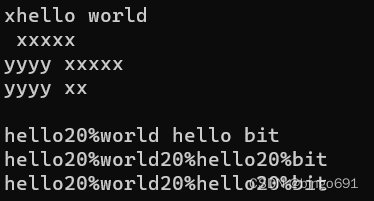

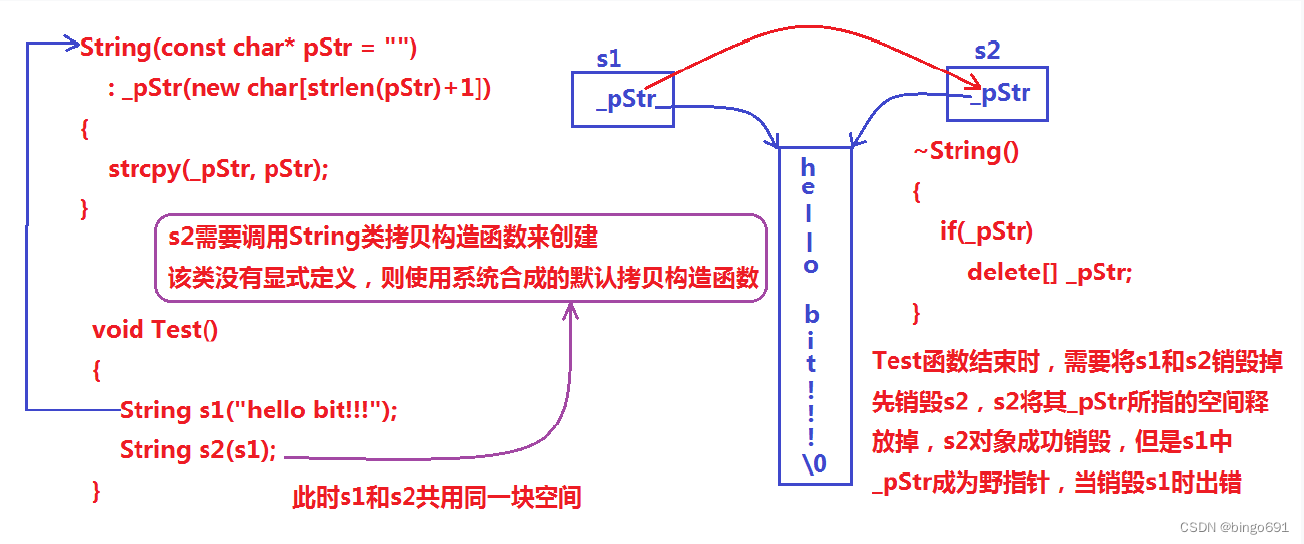
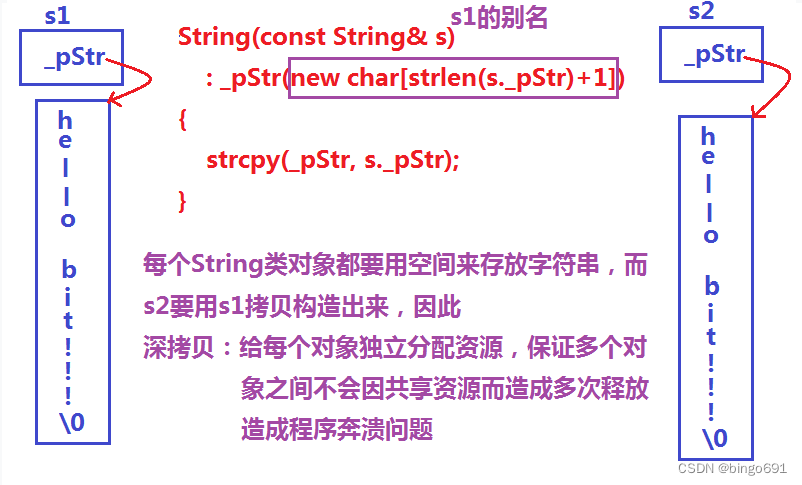
















 1622
1622

 被折叠的 条评论
为什么被折叠?
被折叠的 条评论
为什么被折叠?








